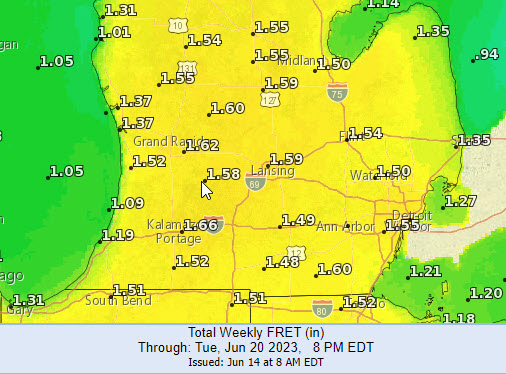June crop water needs
If soils are depleted of moisture beneath the developing plants, irrigators need to supply enough water to help establishing roots grow down into natural soil moisture.

Most years, spring rainfall replenishes the water in the soil profile lost to tillage, cover crops and weeds. Without sufficient spring rain to replace the water lost, producers have the challenge of managing a developing crop that may struggle to grow roots down into moisture, resulting in a need for careful scouting and sharp irrigation management.
Many irrigated fields in Indiana and Michigan were planted later than normal leading to less-developed plants as we enter the typical irrigation season. The less-developed root system and longer and hotter days result in a need for more frequent irrigation during June to keep crops developing. The need for irrigation varies greatly across both states and will vary with rainfall.
Young developing crops like corn at V4 to V8 will typically use 0.5 to 0.8 inches of water each week and soybean in the V1 and V2 stage will use 0.4 to 0.6 inches per week during normal conditions. Crops that have a full canopy like winter wheat and forages prior to cutting will use 1.5 to 2 inches per week.
To avoid getting behind on available water, Michigan State University Extension encourages irrigators to apply irrigation water to make up the deficit between crop water use and rainfall from the previous week. Forcing crops to grow roots into moisture at depth to meet their water needs can deplete the soil moisture reserve, a dangerous position to be in if adequate rains do not return.
Reference potential evapotranspiration (rPET), the amount of water used by a well-watered grass, is expected to be about 1.4 inches for most of northern Indiana and southern Michigan in the third week of June but can vary by as much as 0.5 inch per week depending on weather. The MSU Enviroweather network has links for rPET estimates and related tools for each of its 87 Michigan sites. These data could be used in the originating county or adjacent counties if actual rainfall information from the field is available. The MSU Enviroweather network offers a daily rPET text service to subscribers. In Indiana, rPET estimates from evapotranspiration (ET) gauges are available from the Purdue Agricultural Center stations and can be found at the Indiana State Climate Office.
The rPET needs to be adjusted for the water demand for the specific crop being grown. The ET for annual crops increases until full canopy is reached. At full growth, wheat and alfalfa will have an ET about 5% higher than rPET. Earlier season crops like potatoes that have water use at or just above rPET would use about 1.3 inches of water a week in mid-June. Soybeans at V3 stage would have used 60% of rPET for a weekly water use of just over 0.75 inches. As soybean fields near the R1 stage, they will have an expected water removal equal to our 1.3 inch rPET for late June.

Corn at V6 stage would have used 40% of the rPET for a weekly water use of just over 0.5 inch. Corn at V10 stage would have used 75% of the rPET for a total water use of just under 1 inch for the week. Some corn will be at V12 stage by the end of this week and will have a water removal equal to our rPET of 1.3 inches for the week.
Early-season rooting depth of our crops limits our irrigation application volumes. Applications of 0.75 inch or less are common this time of year to avoid pushing water below the effective root zone but avoid making too many small (less than 0.4 inch) applications that are less effective, and frequent wetting of the plant may aggravate disease. Corn at V6 stage has an expected effective rooting depth of 20 inches.
At V10 stage we would expect corn to have a 23-inch effective rooting depth. By VT (tassel) stage we would expect corn to have full effective rooting depth of 36 inches or more. Soybeans at V3 stage have an effective rooting depth of 16 inches and at R1 stage have almost all their effective rooting depth of 24 inches.
Soil moisture monitoring is useful in understanding whether the field is dry or wet, which can help to determine when and how much water is needed. Monitoring multiple depths of soil can determine which soil depths are dry or wet. There are several ways to monitor field soil moisture content. The feel and appearance method is popular and the quickest method. This requires taking soil samples using a soil probe, auger or shovel, then squeezing the soil samples firmly in your hand several times to form a shaped ball and comparing with photographs shown in the USDA NRCS standard.
Another method is using soil moisture sensors. The sensors estimate soil moisture content based on either the force required to pull water out of the soil (tension) or the electrical properties of the soil, both of which change based on the soil moisture content and soil type. More information about the soil moisture sensors can be found in MSU Extension Bulletin E3445 “Improving Irrigation Water Use Efficiency: Using Soil Moisture Sensors.”
For more information on irrigation water use and when to irrigate, see Irrigation Fact Sheet #3, “Irrigation Scheduling Tools." If you are just getting started with irrigation scheduling, download “Soil Water Balance Sheet." These and other useful resources are available from the MSU Extension Irrigation website.



 Print
Print Email
Email